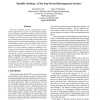Free Online Productivity Tools
i2Speak
i2Symbol
i2OCR
iTex2Img
iWeb2Print
iWeb2Shot
i2Type
iPdf2Split
iPdf2Merge
i2Bopomofo
i2Arabic
i2Style
i2Image
i2PDF
iLatex2Rtf
Sci2ools
ICCD
1996
IEEE
1996
IEEE
Pausible Clocking: A First Step Toward Heterogeneous Systems
This paper describes a novel communication scheme, which is guaranteed to be free of synchronization failures, amongst multiple synchronous modules operating independently. In this scheme, communication between every pair of modules is done through an asynchronous FIFO channel; communicationbetween a module and the FIFO is done using a request/acknowledgehandshaking. Synchronization of handshaking signals to the local module clock is done in an unconventional way [17, 15, 3, 12, 5] -- the local clock built out of a ring oscillator is paused or stretched, if necessary, to ensure that the handshaking signal satisfies setup and hold time constraints with respect to the local clock. We constructed a test bed consisting of two synchronous modules with pausible clocking control and an asynchronous FIFO on a MOSIS 1:2mCMOS chip. The resulting system functions reliably up to the local clock frequency of 220MHz (according to SPICE simulation) -- the maximum clock rate is limited by the ring os...
Related Content
| Added | 07 Aug 2010 |
| Updated | 07 Aug 2010 |
| Type | Conference |
| Year | 1996 |
| Where | ICCD |
| Authors | Kenneth Y. Yun, Ryan P. Donohue |
Comments (0)

